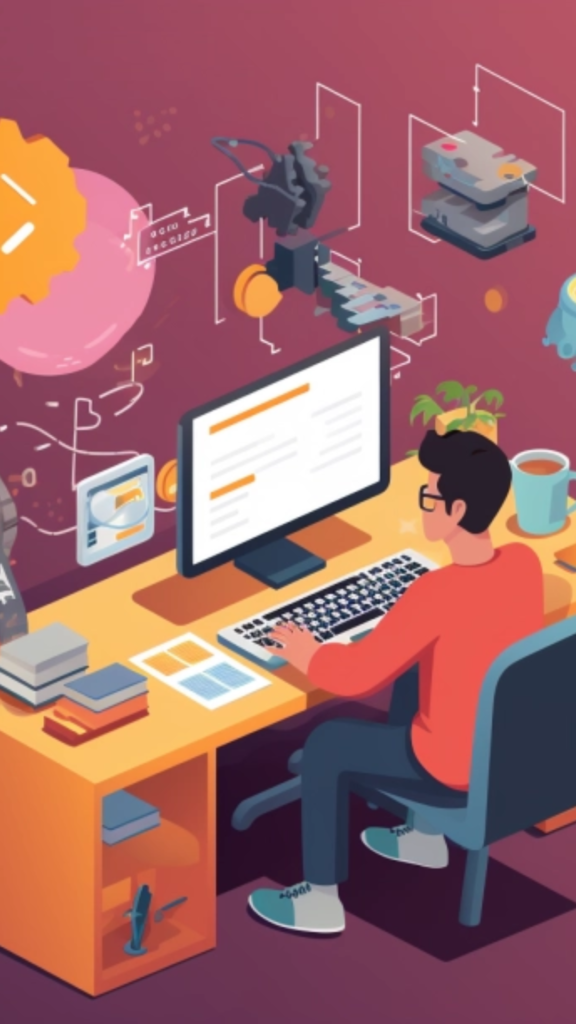Define Java Programming-
It is the process of developing applications for software using the programming language. It was developed by Sun Microsystems (now owned by Oracle Corporation) in the mid-1990s.
It is a high-level, object-oriented programming language that is used for making mobile apps, web apps, desktop apps, games, and many more apps.
It is widely used for making applications of web coding. Developers can choose popular programming languages like to grow their scope in programming. Developers use millions of web applications.
Java is a multi-platform and also a network-centric language that can be used as a platform in itself.

Structured outline of Java complete course using Visual Studio Code:-
Creating a complete Java course using Visual Studio Code (VS Code) involves several steps, from setting up the environment to covering fundamental and advanced topics.
Here’s a structured outline for your course:
Introduction to Java and Visual Studio Code:- Here, you get an introduction to Java program and Visual Studio Code
- Overview of Java helps to gain knowledge about the program
- Installing Java Development Kit (JDK) in your system for better understand
- Setting up Visual Studio Code for Java Development to make your project using it
Getting Started with Java:- Get started on your project with a Java program
- Writing your first program in Java program
- Understanding the concept of program and its full structure
- Compiling and running the code of programs in VS Code
Basic Java Syntax:- Use Java syntax in your Java program because syntax is important to execute the program
- Use all variables and Data Types while performing Java program
- Use all operators and Expressions in your Java program
- Use Control Flow Statements in Java program(if, switch, loops) when needed
Object-Oriented Programming (OOP) Concepts:- It contains data in the form of attributes, fields, or properties.
- Use classes and objects to execute the code
- Use methods to write the code in a proper format
- Use constructors to go your code in a sequence
- Use inheritance to inherit one method of code to another code
- Use polymorphism when you have multiple forms
- Use encapsulation to bundle all the data and it is also used because it makes methods easy to use
- Use abstraction to hide the unnecessary data and only allow necessary data to be displayed on the program
Advanced OOP Concepts:- It gives you more details about the OOP concepts
- Here you can learn how to abstract classes and interfaces in the OOP program
- Add inner classes in the OOP concepts
- Enums are used to represent a group of constants like variables
Exception Handling:- It is used to handle the runtime error
- Use Java program in that case where you need to try, catch, and finally the code
- Use custom Exceptions to handle the code and data
Collections Framework:- It is a collection of framework of Java code
- Here you get the list, set, and map of the program
- Iterating over collections is used for the collection of data and also works to engage all the data
- Using Streams helps you to give sequence to your data and can process your Java style in a functional way
File I/O:- Here is one column for input and output
- Reading from input and writing to files in output
- Serialization means all data is in a serial form and Deserialization means it reconstructs the data
Java 8 and Beyond:- It is a very big thing and also give the introduction of new exciting things
- Lambda Expressions take the parameter and return the value
- Stream API is used to express and process the collection of data
- Optional Class is a container that may or may not contain the null value
Multithreading and Concurrency:- It works to allow the program and continue its programming while others work their program in the background
- Creating Threads means creating new threads to program
- Synchronization works to perform all the things at the same time
- Concurrency Utilities works to enable the tasks and schedule tasks to run
Building GUI Applications:- Here, the users easily interact with the graphical interface like menus, buttons, and icons
- Introduction to JavaFX provides full details about JavaFX
- Creating a simple GUI application to understand the graphical and digital interfaces
Testing and Debugging:- It helps the programmers to remove and detect all errors and debug
- Writing unit tests with JUnit for no error found
- Debugging Java applications to remove the debug from the program
Java Development Best Practices:- Practices make you perfect in Java programming
- Code Organization and Modularity helps to arrange the code in a systematic way
- Java Naming Conventions provide you with a name section for your program
- Documentation and Comments show all the comments given by the users
- Version Control with Git works to record all the changes of data in a files
The step-by-step setup and instruction of Java using Visual Code:-
- Introduction of Java and Visual Studio code- you get an introduction. you get an overview of Java programming, how to install Java Development Kit(JDK), and all the setup for the Visual code for the development.
- Getting started with Java- is the first step before starting a new project on Java programming. It is for beginners, who want to do their project first time using Programming. Here, you can learn after completing the project how to run and compile the code using the project.
- Basic Java Syntax- syntax is very important while writing code because the code cannot work. learn to write in code and give the command. types of syntax that are used in variables and data types, operators and expressions, and control flow statements.
- Object-Oriented Programming (OOP) Concepts- it is an object-oriented programming language that learns its concepts such as classes and objects, methods, constructors, inheritance, polymorphism, encapsulation, and abstraction.
- Advanced OOP Concepts- understand the advanced concepts of OOP by using abstract classes and interfaces, inner classes, and enums.
- Exception Handling- it explains how to handle the exception while programming by using try, catch, finally, and custom exception.
- Collections Framework- discuss the main collections of frameworks that are used in programming like set, list, and map. It also explains the different ways to iterate over collections and how to use streams.
- File I/O- it provides the input and output to the compilers and provides reading from and writing to files.
- Java 8 and Beyond- here, you get the details about lambda expressions, stream API, and optional classes.
- Multithreading and Concurrency- it explains how to create and run the threads and multi threads. Discuss the techniques of synchronization to handle concurrent access to resources and use the utilities of concurrency.
- Building GUI Applications- learn how to build applications of GUI and understand the basics of JavaFX and how to set up and also follow the step-by-step guide to create a basic application of JavaFX.
- Testing and Debugging- after completing the testing, checking errors is a must. learn how to write and run the unit tests and how to use the debugger.
- Java Development Best Practices- understand the organization of code and modularity. how to name the conventions, documentation, comments, and Version Control with Git.
Resources
- Official Java Documentation: Oracle Java Documentation
- Java Tutorials: Java Tutorials by Oracle
- VS Code Java Documentation: Java in Visual Studio Code
By following this structured outline, aspiring entrepreneurs and students can learn programming comprehensively using Visual Studio Code as their development environment.
Here are some key aspects of Java programming:-
Key Features of Java:-
- Object-Oriented: it is built around the concept of objects and classes, which allows for modular, reusable code and easier maintenance.
- Platform-Independent: Java’s “write once, run anywhere” philosophy is enabled by the JVM, which allows bytecode to be executed on any platform without modification.
- Simple and Familiar: it is designed to be easy to learn and use, with a syntax that is similar to C++ but with simpler and more streamlined features.
- Secure: it has built-in security features that help protect against common vulnerabilities, such as buffer overflows and unauthorized access.
- Robust: Java emphasizes reliability with strong memory management, exception handling, and type checking.
- Multithreaded: it has built-in support for multithreading, allowing for concurrent execution of two or more threads for maximum utilization of CPU.
- High Performance: While interpreted languages are generally slower than compiled languages, Java’s Just-In-Time (JIT) compiler improves performance by compiling bytecode into native machine code at runtime.
- Distributed: it is designed to support distributed computing, making it easier to build applications that can run on a network or the internet.
6 Basic Components of Java:-
- Classes
- Objects
- Methods
- variables
- Data types
- Control flow statement
Java Development Process:-
- Writing Code: Write your code in a text editor or an Integrated Development Environment (IDE) like Eclipse, IntelliJ IDEA, or Visual Studio Code.
- Compiling: Use the compiler (javac) to compile the source code into bytecode (.class files).
- Running: Execute the compiled bytecode using the interpreter, which runs the program on the JVM.
Standard Libraries and APIs:-
It comes with a rich set of standard libraries and APIs that provide essential functionality, including:
- java.lang: Fundamental classes and interfaces, such as String, Math, System, etc.
- java.util: Utility classes, including collections framework, date and time facilities, and more.
- java.io: Classes for input and output through data streams, serialization, and file handling.
- java.nio: New I/O classes for non-blocking I/O operations.
- java.net: Classes for networking applications.
- javax.swing: Classes for building graphical user interfaces (GUIs).
- java.sql: Classes for accessing and processing data stored in a relational database.
Conclusion
Java programming is a powerful and versatile skill that allows developers to create a wide range of applications, from web and mobile apps to large-scale enterprise systems. Its object-oriented nature, platform independence, and extensive standard libraries make it a popular choice for developers worldwide.


